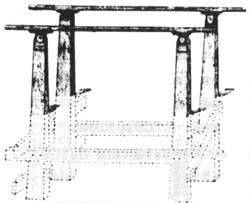| |
|
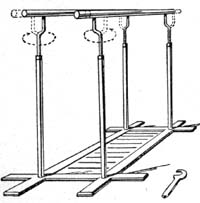
|
| In
Germany it was the pharmacist Hermann Otto Kluge from
Berlin who used tubes to make the parallel bars and
the horizontal bar adjustable and who equipped an own
gym with them in 1856. |
|
In
the mid 19th century, exercises with propping
and pressing were common, dynamic gymnastics was rare.
When
a general improvement in the performances came up
in the second half of the 19th century,
it caused criticism on many sides.
|
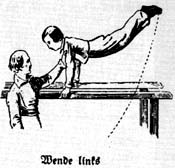
|
In
Germany, this resulted in the so-called “Parallel-bars-dispute”.
Fights similar to that one took place in e.g. Belgium
and Denmark as well. |
|
|
>>>
Germany:
The Prussian
Major Hugo Rothstein, lesson conductor of the Prussian royal
gymnastics institute in Berlin, was mainly orientated on Swedish
gymnastics and even removed Jahn’s apparatuses parallel and
horizontal bars from his institute in 1860. In the official
Prussian curriculum of 1862 these two apparatuses were missing
as well. The three year long dispute was decided by the stepping
in of the physiologist Emil Du Bois Reymond and Rudolf Virchow
(and Euler, Angerstein) as representatives of German gymnastics.
The apparatuses were reintroduced in 1863. |
|
>>>
In Denmark -
- where gymnastics at school has the
longest tradition (since1801)- the student of GuthsMuths Franz
Nachtegall founded the civil gymnastics institute in Copenhagen
in 1808 and by 1814 gymnastics was a compulsory subject including
three lessons a week in all boys schools. In Denmark, a dispute
similar to the “Parallel-bars-dispute” occurred when Rasmussen
wanted to introduce the so-called “Ling model”, which corresponded
rather to the anatomically orientated Swedish model, instead
of the usual gymnastics model by GuthsMuths. In Denmark the
dispute was supposed to be decided by a handbook of 1889, which
was accomplished in 1899 only and which was supposed to “integrate
the advantages of Danish and Swedish gymnastics” in it.
|
Stretched
knees and tiptoes characterized gymnastics at parallel bars (Berlin
school) and also more natural gymnastics of the “Leipzig school” was
far from being full of drive, so that there were few ideas for the technical
change of the apparatus. Power exercises were usual until the 20ies
of the last century.
At
the “First International festival of the International Gymnastics Federation”
in Antwerp in 1903, no swinging element was requested but a handstand
starting from a bended support and a tip over from hanging to support.
The second compulsory exercise at parallel bars did not contain any
swinging elements but a roll backward to a handstand.
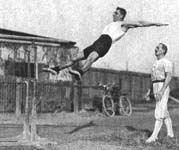
Gymnastics on bars 1928 |
|
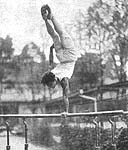
Dual meet Switzerland - Germany in Basel (Wagner / SUI) |
|
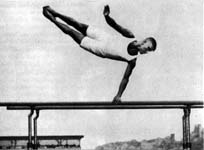
Richard Reuther - some years later one of the most creative
designing engineer. |
In
1909, Hermann Fechner from Dresden offered his iron apparatus
as “best parallel bars of the world” in the yearbook of artistic
gymnastics. A model from Chemnitz followed this, the “patent-split-second-parallel-bars,
Blizzard”. “Fast adjustment. Clicks into place by itself from 5 to 5cm,”-the
model was praised with these words. Firmness and easiness to handle
were required, elastic features were not even talked about.
|
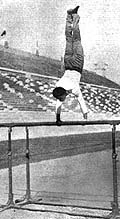
Alfred Flatow, 1896
|
Gymnastics
at parallel bars were also prt of the Olympic Games in Athens
1896.
The German Alfred Flatow is the first Olympic Champion on bars
At the Olympic Games in 1912 in Stockholm,
“pleasant” parallel bars were used, however, the exercises still
consisted halfway of power elements.
Little
changes were made about the apparatuses in the 1920ies.
A standardization of the apparatuses’ features could not be
achieved, neither in the 1930ies. At every competition the gymnasts
had to deal with different parallel bars- once with stiff poles,
then with elastic ones, with heavy or light iron parts and elements
done at one apparatus were simply impossible at another one. |
|
It
was only in the 1950ies, when norms were prescribed. In
Helsinki in 1952, there were still a lot of broken poles (at the uneven
bars as well); only in the mid 1950ies the German Richard Reuther
presented “multipurpose parallel bars”.
Not only the elastic of the poles had increased, but the whole construction
had elastic features. “The apparatus reacts rhythmically on the amount
of effect,” could be read in write-ups. The cross-section of the poles
had changed into the form of drops. In the 1960ies the poles were glued
already, the increased strain on the poles of the uneven bars led to
fillings (from 1963 on: fibreglass), which should prevent breakings.
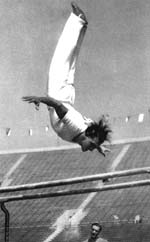
Romero Neri, L.A. 1932 |
|
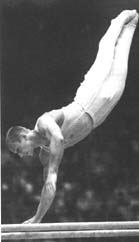
Sergei Diomodov (URS) |
|
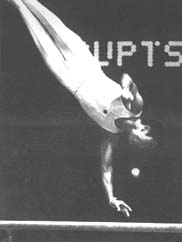
Eizo Kenmotsu (JPN) |
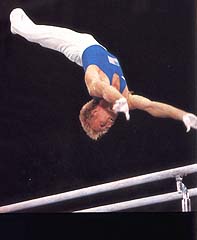
Bart Connor (USA) |
|
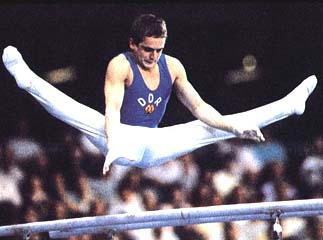
Sven Tippelt (GDR/GER): Element "Tippelt" |
Bars'
virtuosos of
the 2oth century:
Romero Neri
Olympic Champion 1932
Sergej Diomidow
World Champion 1966
Eizo Kenmotsu -
World Champion1974, 1978
Bart Connor
World Champion 1979, Olympic Champion 1984
Sven
Tippelt
WCh Bronze 1987,
Bronze OG Seoul 1988
|
J&F
WORLD CHAMPIONSHIPS APPARATUS, Ghent 2001:
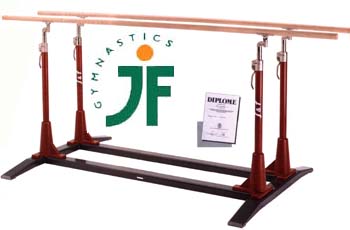
J&F
COMPETITION PARALLEL BARS
F.I.G. approved;
|
|
It is incredible that the modern
parallel bars of today do not lose their stability, in spite
of giant circles and flying elements or the dynamic elements
on the sides.
It is perfectly natural that
user-friendly features like adjustable parts for the sides
and height as well as transport and erection are included
in the service of the constructors. With regard to that, the
world’s best gymnasts will enjoy first quality in Ghent.
<<<
The heavy cast supports on a steel base, offer a high degree
of stability and rigidity and are provided with a patented 3-point
locking mechanism to avoid accidental loosening of the columns.
With patented high-frequency glued plywood rails wich are reinforced
with fibreglass insert for better strength and flexibility.
|
|
Back
to NAVIGATION
|
| Sources/Quellen:
"Der Vorturner", 1927/28; "Das Turnjahrhundert
der Deutschen", Götze/Herholz: Beckmanns Sportlexikon A-Z,
Leipzig, Wien 1933; "Deutsche Turnzeitung", 1901;
"Neue deutsche Turnzeitung", 1961, J. Leirich; "Geschichte
der Turngeräte", J. Göhler/R. Spieth; "Mondsalto",
gymbooks Verlag 1994, A. Götze/J. Uhr; "FlickFlack...",
Sportverlag Berlin, A .Götze/H.-J. Zeume; "The History
of British Gymnastics", 1988 by BAGA. |
|

